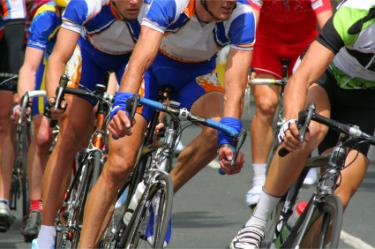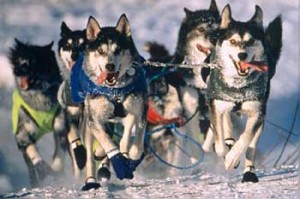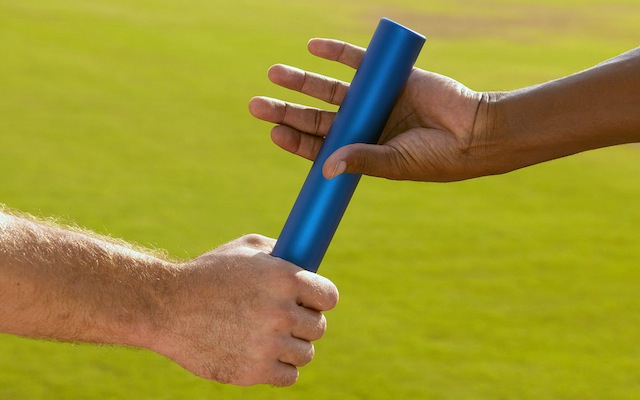Dr. Steve Phinney —
I can ride continuously for three hours and go 60 miles without any hunger or food cravings or drop off in performance. And I ride as well in the last 20 miles coming home as I do going out.
Steve Phinney, can you tell us who you are?
I’m a medical doctor and have my training in internal medicine. Early in my career developed an interest in nutrition and got a PhD in nutritional biochemistry. That was 30 odd years ago, and since then my primary interests have been in weight management, ie, obesity, exercise and the human economy of the various fats we either put in our mouths or make in our bodies.
You’re a star in a Canadian documentary called My Big Fat Diet, because you helped a whole group change their eating habits to reduce insulin resistance and lose a lot of weight. you’re the co-author of a book about the Atkins Diet that’s been updated by you and two other clinician scientists.
Partially correct. I had a bit part in My Big Fat Diet. The star is Dr. James Wortman, a Canadian physician. And yes, I’m a coauthor of the updated, new Atkins book which came out last March.
You’re also in the process of creating a new book that’s more technical about high fat diets.
That’s correct. Dr. Volek, who’s one of the coauthors on the Atkins book felt, like me, that we needed to offer more information for people who are interested in the medical side of low-carb diets, with a more detailed explanation of the workings of the human body when carbohydrates are restricted. It’s readable by both a health care professional and an interested, educated lay person.
Are you an athlete?
I’m physically active. Though after high school, I’ve not been involved in competition athletics.
Do you eat a low-carb, high fat diet?
Yes, guilty as charged.
How low carb and how high fat?
I stay between 25 and 50 grams of carbohydrate a day. I eat a moderate amount of protein. It’s not a high-protein diet. I eat 2800 calories a day, and so if moderate protein is 500 to 600 calories a day and carbohydrate is around 100 calories a day, I’m eating over 2,000 calories of fat to maintain my body weight. I run in the 70 – 80% of energy intake as fat.
From what most experts say about physical exercise, your muscles must be in shreds. You’re not eating food that puts big stores of glycogen in your muscles. Are you constantly sore and fatigued.
No, and one of the most fascinating things about switching from a high carbohydrate diet, which I used to follow, to a low carb diet, which I did six years ago . . . My primary form of purposeful exercise is bicycling, and my distances range from 20 to 60 miles, and I”ll do two or three rides a week.
I used to classify my rides as one banana rides, or two banana rides or three. If I rode 60 miles, I had to take three bananas with me and had to eat one every hour. Otherwise, I would be running out of power and dragging my tail home, or ordering a taxi.
That’s because my body would run out of carbohydrate fuel, and even though I had tens of thousands of calories of body fat, I couldn’t use it efficiently for exercise. That’s where the concept of needing carbohydrates for exercise came from.
If a person goes through a few weeks of giving the body time to adapt to carbohydrate restriction–you do have to go through this gauntlet of forcing the body to adapt to a low carbohydrate diet, meaning let the cells alter their enzyme levels to efficiently burn fat for fuel, then, when I set out for a ride, I have 40,000 calories of body fat, and that’s accessible to me.
I carry no food now on my bicycle rides. I carry water, but nothing that can raise my insulin levels, and now, I can ride continuously for three hours and go 60 miles without any hunger or food cravings or drop off in performance. And I ride as well in the last 20 miles coming home as I do going out.
Maybe you’re riding more slowly than when you were doing the three banana rides.
No. I ride as fast now, and I’m six years older now than I was when eating carbs. And I’m at that point in life where my performance theoretically should be dropping off because of age, and I can ride 18 to 20 miles an hour still, and if some young person tries to speed up and go by me on a ride I can jump on their wheel and stay with them, just as well as I did ten years ago.
So you don’t need to have carbs to keep you going? You don’t hit a wall the way you did when you were eating carbs?
That’s correct. My gas tank got a lot bigger when I gave up carbs. Because we can only store maybe 1500 calories as carbs. If I burn 600 – 700 calories per hour, and I depend only on glycogen, that’s about two hours of fuel. But if I have 30,000 to 40,000 calories of fuel in my fat, I can ride for days.
If you have that much fat on your body, does that mean you’re fat?
Body fat is in cells and there are cell membranes and cell nucleus and so on, and if you take that into account, then one kilogram, which is 2.2 pounds, contains about 7,000 calories of fat. So if I have 40,000 calories of fat on my body, then I have about 6 kilograms of fat, meaning 12 to 14 pounds of fat on a body that weighs about 165 pounds. I probably have more than that. But my percentage of body fat . . . So around 15%. Pretty lean for a guy my age. A highly trained male marathon runner might be 8% fat, and if he weighs about 150 pounds, that’s about 12 pounds body fat, or about 40,000 calories of fat.
Are you the only person who uses a low carb diet and succeeds as an athlete?
Many people do, and they anecdotally note that their performance is as good or better than it was on high carbs. Dr. James Wortman, for instance, the star of My Big Fat Diet, discovered in his 50s that he was a Type II diabetic, a disease that runs in his family. He switched to low carb eating and his diabetes is completely controlled. He’s an avid skier, and I have personally seen him do a non-stop in a 5,000 foot descentof Whistler Mountain in British Columbia. Obviously he’s not impaired by the way he eats.
But many sports physiologists warn that it’s not possible to be an athlete on a low carb diet. They say that glycogen gets impaired on a low carb diet. Glycogen is a starchy substance that’s made from sugar and stored in our cells.
Glycogen does go into the muscle and liver. The muscle glycogen gets burned only in that muscle. The liver glycogen can be released into the bloodstream which is necessary to keep the brain happy. The body’s energy economy includes not only fueling the muscle but fueling the brain. If the brain fuel supply drops, you don’t feel well. That’s called hitting the wall by runners and among bicyclers, it’s called bonking.
But the studies looking at carb dependency were all done for less than two weeks. No study that went longer than two weeks has demonstrated the benefits of a high carb diet. I personally put highly trained bicyclists on an Inuit diet for four weeks. That’s the people who lived in the Arctic who ate a very low carb, very high fat diet. For the first two weeks, the bicycle racers reported that their training was impaired and they didn’t feel well. They were struggling with keeping up their training schedule. But after two weeks, they reported feeling well and their performance, on tests, came back. and I knew this was true because I had to ride with them to keep them from stopping and eating something they shouldn’t. We measured their peak aerobic power and their endurance time to exhaustion. We did before and after performance, Same power curves on the indoor stationary bicycle at a set wattage over a period of time. There was no reduction in performance after they had adapted for more than two weeks to a ketogenic diet.
As I did that project I became curious about people who had lived on that kind of Inuit Diet. I read the journals of Arctic explorers. One of them was a US army surgeon named Frederick Schwatka. In 1881, he set out from the west coast of Hudson’s Bay. He traveled the Arctic, overland with Inuit families, in search of a lost Royal Navy expedition that meant he traveled 15 months, over 3,000 miles on foot, in excellent health.
In his journal, he wrote, When first thrown wholly upon the diet of the native, one is ill-disposed to travel. There is a weakness of the legs. But this passes away after a few weeks and then long sledge travel are possible.
So it’s not just me. It wasn’t just my bike racers. It’s many people who find that when the body is given time to adapt, it’s remarkable in its ability to switch from dependency on carbohydrate, which is a very small fuel tank to the ability to access fat reserves without impairment of aerobic power and performance.
Steve Phinney, when you say adaptation takes two to three weeks, could someone be adapting by eating a low fat diet one day and a high fat diet another and gradually ease into this?
We have not studied that. But informally, when people try that, they just feel lousy. It’s a roller coaster ride, where you have a huge surge of insulin. Then you deprive your body of the carbohydrate fuel. The process of adaptation requires a consistent period of time for the body to make its peace with not having carbohydrates. Most of the adaptation occurs in the first two weeks, but some of the fine tuning is going on four to six weeks after that.
What if someone’s afraid of fat, but they understand they need to cut back on carbs. So they eat a 14 ounce steak at night to get energy from the protein in the steak. Are they doing what you recommend.
The Inuit were not a literate culture, meaning they didn’t write down what they ate. But people who lived among the Inuit and, I think, accurately recorded it, pointed out that the Inuit avoided actually eating lots of lean meat. They had a name for an illness that happened if they ate too much protein and not enough fat. The English translated the name of that sickness as “rabbit illness,” because, if the Inuit had run short of their winter supply of food, the spring rabbits they could hunt were extremely lean, and eating too many made the Inuit feel sick. If the Inuit killed a caribou that was not yet fattened up in the Spring yet, they would preferentially eat the tongue and the bone marrow and the liver, which are the fattiest parts of the animal. They would save the roasts and steaks, which we consider the delicacies, those were saved for the dogs, because that was more lean, and a dog’s metabolism is more suited to handling a high protein meal. The Inuit instinctively understood that. They saved the fat for themselves, and they gave the lean to the dogs. That way they saved themselves from gastrointestinal upset, swelling, malaise and in the most severe cases, kidney disease.
Well, how about if, instead of eating just the leanest part of the meat, what if they eat a 14 ounce rib-eye steak. Or chicken with the skin. Will they avoid a rabbit fever problem, or is that still too much protein?
A lightly marbled steak, in terms of energy, is about 50-50 protein and fat. A heavily marbled steak is 75 percent of calories from fat and 25 percent from protein. Chicken, with the skin, dark meat’s going to be 50-50 protein and fat, but the white meat is going to be more protein, even with the skin on. So as an energy source, it’s too much protein . . . UNLESS the person is trying to lose weight, and getting fat from their body’s own fat stores. In other words, being on a higher fat diet because they’re getting fat from their body’s stores.
After all, many people, choose a low carb diet for weight loss. For them, a diet that’s moderate in protein may be high in fat because they’re burning their own fat for energy. When you go on a weight loss, ketogentic diet, you can eat less fat on your plate because you’re burning the fat that comes from your inside. It comes from your love handles and hips and so on.
When burning your own body fat, it looks like it’s a high protein diet. But the scales go down because the body’s burning it’s own fat stores. But if that persons loses weight and decides to stay on low-carb as a maintenance diet, in order to become weight stable, they need to eat a considerable amount of fat now, in other words, they need to increase their fat intake, which should work fine, because by now, their body should be very efficient at burning fat.
Well, if an athlete is eating a 14 ounce steak, is that too much protein?
It depends on the person’s height and weight. Also, the amount of protein you eat depends on how much muscle you need to maintain. So a tall, muscular man would need more protein to maintain lean body mass than a small less athletic woman.
Let’s describe an athlete about 6 feet tall and pretty muscular.
So his reference weight would be 80 kilograms, plus or minus a few. We recommend that on a low carbohydrate diet, people get 1.5 of protein per kilogram of body weight. So that would be 120 grams of protein. That’s the low end. And it can go to 2 grams per kilo, or 160 grams of protein per day. Now, a 14-ounce steak–each ounce of prepared steak has around 7 grams of protein, so it is just a bit shy of 100 grams of protein. If a person’s intake should be between 120 and 150, that steak represents more than half of their daily protein needs. So if the person had two eggs and 2 strips of bacon for breakfast, which would be about 25 grams of protein, and some tuna with celery and lettuce for lunch and then the steak for dinner, that might be about right for total protein. So that would be tolerable, as long as the person didn’t feel deprived by waiting for the high amount of protein in their evening meal.
That would be too much protein for me. I’m about 5 foot 7. And because I have a weak pancreas, I don’t have a lot of room for extra protein calories that might be converted to sugar. It would push my blood sugars up. That’s what happens to protein if someone eats too much.
So I try to eat less protein. Mary Gannon, another expert on protein metabolism would point out that people can have far less protein than you’re suggesting, because so much of the body’s protein can be recycled and used again. While you, talking about athletes, are talking about more protein than that.
When we fed the bicycle racers in my study 30 years ago, we didn’t try different protein levels. Instead, I picked the grams of protein per kilogram, referenced to body weight, based on a 1930s paper about an Arctic explorer who had lived among the Inuit and then consented to be locked up in a research hospital in New York City for the better part of a year, to allow people to study his adaptation to one similar in composition to the Inuit diet. He ate 1.7 grams of protein per kilo. So that’s what we fed my bicycle racers. Of course, they were not diabetic. They were highly trained athletes. For my bicycle racers, it seems this amount of protein allowed their bodies to adapt to a state called nutritional ketosis. That allows fuel for the brain and many other tissues happens when carbohydrate intake is limited. It did not cause any kidney problems. They appeared to be very well adapted to that level of protein. Note that athletes, even on a low carbohydrate diet, your body accumulates some glycogen from protein molecules, and they use it when they exercise and then rebuilt it the next day or two.
So you’re saying it’s okay to eat a fair amount of protein, as long as it’s not too much and you also eat a lot of fat. You can get by with a moderate amount.
That’s explained in a chapter in the new Atkins book, and it’s explained in detail in a new book we have coming out. Because it’s a question we get from many people. There’s a misunderstanding about the Masai, the the native plains indians who lived on the buffalo and nothing but the buffalo, or the Inuit had no opportunites to farm. The Plains Indians and the Masai could have farmed, but they chose not to. They were able to eat that diet, eat a variety of foods that didn’t include agricultural carbohydrates. They grew very strong, very tall and were not impaired by that level of fat intake.
You’re convinced that many of these people chose to eat a low carb, high fat diet on purpose, even when carbohydrate calories were available. And on this diet, these were great athletes of other times. But we’re in this modern science era, and we’ve talked a little about glycogen stores. The concern of many sports physiologists today is that a high fat, low carb diet will damage muscle. The glycogen level will not be high enough to give their muscles a fuel for sprinting. I’ve heard sports physiologist say that if you don’t have enough glycogen, you will injure your muscles because they won’t have enough fuel to repair themselves.
That has no basis in physiology. If the muscle’s exhausted, you stop. There are occasionally conditions that occur with excessive physical performance called rhabdomyolisis which means death of muscle cells. It can be life-threatening. Sometimes soldiers get this when they’re trained excessively and pushed beyond their limits. Sometimes someone who’s not an athlete trying to do a marathon can have this muscle breakdown. Sometimes someone on statin drugs can suffer from this condition as well.
But it’s not caused by a lack of glycogen. There is now a group of athletes who do endurance events such as trail runs ranging from 50 to 100 miles, and a major problem with people on trail runs eating a high carb diet is that they have to eat every hour, and if it takes 17 hours, start to finish. Without sleep. It’s 100 miles, with 20,000 total feet climbing and total descent . . . some of the people doing these races are now training low carb for these races. These people tend to start fairly slow in the race and be in the middle of the pack halfway through the race. But then in the second half, they tend to eat up the field from the back. Because they have a sustained fuel supply–their body fat–and they can continue running. A couple of women are extremely good at this, and in fact, running on low carbohydrate diets, these women not only have won the women’s races, but they have placed high in the men’s fields. People are wondering what the heck they’re up to, and they’re not saying much because their diet is a sort of secret weapon.
Are they sprinting sometimes or going at a nice steady pace?
This is a race where you can’t sprint. It’s more of a steady pace, because they have to stay at it for the next 20 hours.
Perhaps a low carbohydrate diet is more suited to a cruising speed and not for sprinting. Isn’t the fuel for sprinting glycogen? After all, fat is more of a cruising fuel than a high octane fuel.
Right. But what if your rate of glycogen use can be cut by a factor of four? And while you’re starting out with half as much glycogen as the person next you eating a high carbohydrate diet, but you’ll use up your glycogen four times more slowly than the person on a high carbohydrate diet. Whose glycogen will be more likely to last? The person whose rate of glycogen is a quarter as much, and their tank is half empty? Or the person whose glycogen level is twice as high but uses it up four times faster?
And those are actual numbers. We took bits of muscle out of their thigh muscles and measured muscle and measured glycogen before and after. On the same duration of riding and the same intensity, their rate of glycogen use was one-fourth as much.
They started with a lower amount of glycogen than someone eating a lot of carbohydrates, but they used the glycogen so efficiently, by the end of time that they were exercising, their stores were as good or better than someone who was eating carbohydrates?
Right. And the other thing that happens as a body gets more adapted to low-carb over two or three or more weeks, and thus it improves the body’s ability to manage its fuel supply, then the body becomes an extremely effective scavenger of the various breakdown products that can be used to make more glycogen. A lot of athletes and trainers fear a chemical compound called lactate. Lactate is what your muscles make out of glycogen when you’re sprinting. Lactate collects in the muscles. It accumulates in the bloodstream. It’s said to be a factor causing fatigue and muscle pain. It changes the pH in the blood to breathe hard. That makes you pant. That’s the pH lactate effect.
That used to happen to me, when I was eating a higher carbohydrate diet. But now that I’m adapted to a ketogentic diet, when I’m sprinting on my bicycle, for instance, when I’m chasing some younger person I don’t want to let go by, I breathe hard but I never huff and puff. That’s because I don’t make as much lactate, so I don’t have that lactate surge. But even more important, my muscles have become extremely efficient at taking lactate back up and using it to make glycogen. That was discovered by some Scandinavian scientists fifteen years ago. They found that the muscles that you’re not using doing exercise actually become a sponge for taking up lactate to make more glycogen. Your liver can take up lactate and make it into glycogen. You can use the skeletons from the amino acids in the breakdown of protein to make glycogen. In these ways, a keto-adapted athlete is probably much more efficient at recovering and rebuilding the glycogen stores they need.
An example of that is a study done in Arctic sled dogs by a scientist from Oklahoma State University, named Dr. Mike Davis. He’s a doctor of veterinary medicine, and he took a couple of racing sled dogs up in the Yukon and raced them 100 miles a day for five days in a row. They did a half Iditarod distance, going around the same 100 mile loop every day for five days in a row. He fed the dogs a high fat, moderate protein, low carb diet.
He measured muscle glycogen in the dogs before they started. At the end of five days, he did muscle biopsies on the dogs again. That’s after racing 100 miles a day, pulling a sled, being fed adequate calories in a low carb, moderate protein, high fat diet. At the end of five days, they had more glycogen in their muscles than they did when they started. Their muscle cells were sucking up every little bit of what they could find and putting it right back in the muscle as glycogen. And doing it much more efficiently than when they were fed a high carb diet.
It the trainers had said, these poor dogs are working so hard, let’s give them a few starchy biscuits, would that have been okay or would it have messed up their adaptation?
We don’t know. Because that experiment has not been done. But based on our human experience, the human body loves consistency. If you’re eating carbs, you have to keep eating carbs to maintain that sense of well-being that comes from that sugar surge. Not running out of energy and not being put in a position of bonking. If you flip the coin over and go to the low carb high fat side and do a few weeks of adaptation, that’s what your body wants to get. Our experience is that even a transient break in a low carb diet is an uncomfortable experience.
For instance, on a low carb diet, the kidneys are very efficient at getting rid of salt and water. That’s why, when someone’s kind of bloated and goes on a low-carb diet, they might lose 8-10 pounds in the first week. Now they don’t lose 10 pounds of body fat right away. They lose 2 or three pounds of body fat, and they lose 6 or 8 pounds of water because of salt excretion. But if you break the keto-adapted state. Say you ran a 10K, and to reward yourself,you eat a big plate of pasta. Well, the next morning you’re going to feel like the Michelin Man because every drop of salt and water will be suddenly trapped in your body, because your kidneys aren’t excreting salt when you’re eating carbs, and the scale will go up six pounds.
For example, take the bike racers in my study. We didn’t try to convince them that they might want to be on low carb long term. We just encouraged them to stay on the on the diet while we were studying them. When they came off, we wanted them to transition back to a high carb diet. These guys had been locked up in a metabolic research ward, and so I would take them out to any restaurant they wanted and treat them to a meal. I saw one guy eat a 16-inch diameter deep dish pizza. The whole thing. It’s about 2,000 calories.
The next morning the guy weighed six pounds more than he did the day before. He didn’t gain six pounds of body fat. His kidneys shut off salt excretion. Every bit of salt and water he had in him that night just stayed with him. It takes two or three days for the body to settle down and get rid of that overt retention of water.
The adaptation to a high carb diet is much quicker than it is adapting to a low carb diet. And these athletes . . . . They were so fit and capable, they could chose which they wanted to do. Be a carb eating body or a not carb eating body. But what about someone who’s a diabetic — or your word — carbohydrate intolerant? You caution there are ways you can be miserable even if you are eating low carb and you’re diligently avoiding carbs, but you have enough salt or magnesium. Which do you want to talk about first?
Let’s start by talking about salt. After all, salt is controversial. Sodium. As I mentioned, when the human body adapts to low carb, the body becomes very efficient at excreting salt. That’s good if you have high blood pressure, or if you’re bloated and fluid overloaded. It’s fine to reduce that. But there is a certain amount of salt our body needs. If you ever bit your lip and tasted your blood, it’s salty. The blood in the body contains salt. That’s the mineral in fluid outside to cells. Inside the cells, the body contains potassium. The body basically has two separate zones–the sodium zone in the bloodstream, and the potassium zone inside muscle and liver and kidney and heart cells.
If you don’t have enough sodium, particularly if you start to exercise and you’re warming up. Warming up means you’re getting blood circulation into your muscles plus to your skin to help you cool off. When you’re trying to cool off and work your muscles at the same time, your blood’s trying to serve two masters, which it can do if there’s enough blood. But if your fluid level is too low in the bloodstream, meaning too little volume altogether, then you’ve got too little to do both these tasks. Your blood level falls short. People who experience this lack of blood circulation, well, that can make people feel light-headed, dizzy and intensely fatigued.
I’ve had people tell me, I tried that low-carb diet of yours and the scales went down. But I was so light-headed. If I took a hot shower I’d feel like I was going to pass out, because I was completely washed out. That diet’s worthless!
I’d say to them, would you try drinking a cup of bullion.
Too much salt is bad for you, but the right amount is necessary?
I had a neighbor who was president of the local road riding club, and he tried a low carb diet, and felt really tired. I explained to him about salt and encouraged him to add some. He tried it. The next time he saw me, he hugged me and said, ‘You’ve given me my power back!’
Let me see if I’m understanding this. You said add two grams. That’s like a quarter teaspoon of salt. Maybe in total an additional half a teaspoon of salt in the day. And not only that. It has to be timed within, preferably, one hour before you try to do a lot of physical activity, or at maximum, around four hours before you do exercise. Don’t do it right before you exercise. And . . . It’s not like, do this before you go to sleep at night. Drink the bit of salt an hour or an hour and a half before you exercise.
That’s right. The sodium you ate yesterday is gone by today. If you want to take bullion before you go to bed, it depends on what kind of exercise your’e going to do in bed. It’s not going to help you tomorrow.
So if you get up in the morning and you go for an hour run between 6 and 7 in the morning. Then drink a cup of broth around 6 in the morning. The broth is not going to fill you up but it will give you some sodium. Drink it and then go for your run and you’ll feel infinitely better.
Maybe I’ll try this playing tennis, so that at the very beginning of the tennis match I’ll have more energy. After all, right now, the first set is usually my worst one. And I’ve always assumed it’s because I’ve got a weak pancreas. And since my pancreas is small, I know that the sprinting in tennis can push my blood sugar up 100 points, but maybe my fuzzy feeling is not because my blood sugars are going up. Maybe I’m a bit fuzzy in that first set. because my blood pressure’s low and I don’t have enough salt to push up the pressure and get all the tasks done that blood needs to do at that moment. Maybe if I drink something salty an hour or so before I play tennis, I won’t be as fuzzy.
Maybe so.
But of course, the sodium won’t affect my blood sugars. After all, I’m in a body that’s releasing sugars without having insulin to push the sugar into my cells. So my blood sugars go up.
That’s lactate coming out of your cells, being picked up by the liver and being made back into glucose and getting sent back to the cells. That’s called the Cori Cycle.
Since I don’t have a lot of insulin, my body goes, what the heck are we going to do with the sugar stuff. So my blood sugars go up.
Actually, some of that happens to anyone who’s got insulin sensitive cells and is exercising. Now if someone’s cells are insulin resistant, exercise does, indeed, lower blood sugars, because it makes their cells more insulin sensitive. But for someone who’s already insulin sensitive, even someone with a normally functioning pancreas, their blood sugars will go up at least some as a response to the Cori cycle’s extra production of sugar from the lactate that’s being released in the blood.
For instance, with my bike racers, we did blood tests before they started exercising, 15 minutes into the exercise, an hour and half into the exercise, then just before they finished . . . ie, when they said, I’m exhausted, and we said, “wait wait, let me get one more exercise blood sample . . . you see, we had IV’s inserted into them, so we could do it fairly quickly. Anyway, we did it in those times when they exercised, and then one final time, five minutes after they stopped peddling . . when we did that with the athletes, the highest blood sugar we recorded was generally 15 minutes into the exercise, and that higher blood sugar was in response to the initiation of exercise. This even happened to these highly trained athletes.
So every athlete, IF they’re insulin sensitive, their body responds by raising blood sugars in the first hour.
Yes, and it’s worth noting that the rise and fall of blood sugars in my bike racers was more extreme when they were on a high-carb diet than when they were on a high-fat, low-carb diet. In both cases, their blood sugars went up in the first fifteen minutes, and then down low afterward. But on the low-carb, high-fat diet, the highs weren’t as high and the lows weren’t as low. It’s a much more even flow of fuel.
I notice that in a singles tennis match, my sugars will go up to 170 to 180 but as time goes on, I can stay with sprinting. I have more endurance than someone who’s eating carbs. I haven’t thought I needed salt for starting fast in exercise.
For a better amount of minerals, there’s a recipe in the Atkins book from last March for meat broth. To make a meat broth, I say buy a whole chicken and put it in one quart of water for every pound of chicken, and simmer it for around six hours. Then throw away the solids, or give it to your cat or dog. And save the broth. Because the really good stuff is in the broth. Now I can buy chicken for a dollar a pound at my local bargain grocery store, and I get a quart of broth per pound of chick, and I use two cups per day. So I get two cups of broth for fifty cents a day. Now, to me, that’s a deal. After all, I would not bat an eyelash to go down to my local custom coffee place and buy a coffee beverage for three dollars. And be happy for the pick-me-up from the coffee. So the pick-me-up from the broth is not a waste, and it’s not expensive.
Now to best use the broth, I recommend that you skim off the fat, because I doubt that factory chicken fat is all that good for us.
Even you don’t like factory chicken fat.
I don’t like factory chicken fat. Try saying that fast three times. But in addition, it’s been exposed to heat and oxygen for a long period of time, and any polyunsaturates are going to go rancid as a result of that cooking process, so I skim the fat off and throw it away. But what’s left, the broth, in the refrigerator, it turns into a jello consistency. That’s because it’s got as much protein per cup as a whole egg.
So real broth counts as a protein source.
Yes it does. And you also get potassium and magnesium out of the muscle meat and phosphorus and calcium from the bones. It’s an extremely rich mixture. And I have people put one teaspoon of salt per quart into the pot when they make it. That gives you one-quarter teaspoon per cup. You get the right amount of salt, some extra potassium, some magnesium, and it’s extremely good for your muscles and for me, it also feels good for my gastrointestinal tract. Even viscerally, it appeals to me.
For someone who’s depleted of magnesium, as evidenced by leg cramps, you suggest magnesium supplements. I’ve had muscle cramps, so I tried to find the slow-release magnesium you suggested. At Whole Foods, they suggested a product known as Calm. You put it into hot water, it fizzes and you drink it. And it comes in a sugar-free version.
Magnesium is a fascinating mineral. I class it as my least favorite nutrient, because like Rodney Dangerfield, it never gets any respect.
Ninety-eight percent of the free magnesium in our bodies is inside our muscles. There’s a fair amount of magnesium tied up in our bones as well. One tenth of the positive charged particles in our bones is magnesium. The other nine out of ten is calcium. But the magnesium in bones doesn’t get released very fast. So your body can’t borrow from the bone magnesium in order to help out muscles that are depleted in magnesium. If you need to get some in your muscles quickly, the bone isn’t any help at all.
Now there are some clues of magnesium deficiency. For instance, the little twitching of the muscles is a sign–little fasciculations–little twitchings. Or the whole muscle may twitch and lock up. That’s a cramp. Frequent muscle cramps after exercise or in the nighttime are for me a very strong sign of magnesium depletion. Now, you can get a blood test for magnesium, but it’s not going to tell you really what’s happening in the muscles. That’s because 99% of the magnesium is supposed to be in your muscles, not in your blood stream, so the blood levels are not a good indication.
Now, if I wanted to get some slow-release magnesium tablets, how could I?
The place where I buy the slow release magnesium is at my local Costo warehouse store. But they don’t put it in the general shopping area. They have it in the pharmacy area because they’re not allowed to sell it as a bulk item. It’s not prescription, but you have to ask the pharmacist for it. It is also available from on-line retailers like Amazon. There was a proprietary, patented product introduced a long ago called Slow Mag. There are now some generics that cost less called Mag Delay and Mag 64, meaning 64 milligrams of magnesium per tablet. The reason I like the slow release is the human digestive tract is not good at handling a large does of magnesium. When it gets a large dose of magnesium, it’s natural instinct is to dump it. That’s why Milk of Magnesia is a laxative. So if you use a slow release magnesium.
If you took three slow mag pills, which is about 200 milligrams of magnesium. That’s roughly what you want.
One clue that someone’s taking too much magnesium at a time would be diarrhea. That would be a hint that it’s too much magnesium for the total day or too much at one time. But when it comes to salt, you say try to time it for when you need it for exercise.
Sodium only has one positive charge, so it moves rapidly into cells. As does potassium. Magnesium, like calcium, has two charge molecules, and absorption of divalent cations (sorry for the big word) — molecules with two positive charges — is much slower. They move much more slowly into cells.
I’m going to switch to discussing A Type 1 diabetic told me he’s been eating 100 grams of carbs a day, and he’s recently switched to 50 grams of carbs a day.
He said his hemoglobin A1c is around 5.9. His blood sugars are in the 170s to the low 90s. But he used to run 8 miles every morning, and right now he can barely walk. He feels like he needs to go to sleep at 9:30 in the morning.
The first question is, is he drinking broth?
I think he told me that right now, it’s 500 milligrams. That seems 3 1/2 grams less than you suggest in a day.
People have developed such a phobia about salt, and very frequently, people on a low carb diet are not taking in enough salt. The two or three grams I’ve mentioned, or basically a quarter teaspoon before exercise, that’s the amount you need to prime your circulatory pump in preparation for exercise.
Those are his two or three weeks of adaptation. And fifty may not be low enough, and he might need to come down to 30 or 40 to get adapted. He’s still in that Schwatka moment. Schwatka said it takes at least two weeks when one goes fully on the diet of the native. But as a Type 1 diabetic, his window of carb intake may be much more narrow, which means he may need even less carbohydrate.
Dr. James Wortman tracks his hemoglobin A1C very closely. He’s been under 5.5 on his A1C since 2002. He can’t eat more than 40 grams a day without noticing a change in hemoglobin A1c. He stays 25 or 30 grams of carbs a day.
Now Type II diabetics, under standard medical care, (which usually means they are told to eat a low fat diet), they are extremely difficult to get even close to normal A1cs. Very often, using standard diabetes care practices, we see a poorly controlled Type 2 diabetic, and we’ll be happy to get them down to 7.
You mean, the typical diabetic treatment through the medical community, which tends to be a carb diet of at least 150 grams of carbs a day, plus lots of medications, that kind of diabetic has a hard time getting blood sugars down below hemoglobin A1C of 7.
And the medications used to control blood sugars make a person gain weight and have a lot of side effects. In contrast . . . What happens when you take away the carbs is you take the pressure off the system. Their blood sugar gets under better control, their blood lipids go down, and they lose weight. So all the things work in the right direction.
So, the suggestion for this gentleman is give it some time. Don’t be impatient. Broth an hour before exercise. Try getting the carbs even lower. And I like to see blood sugars stay under 150 all the time.
If he had an 8-ounce steak and large salad and buttered green beans, he might have a sugar go up to 150 just from the gluconeogenesis during digestion and through the clearing of the protein. But we want it to level off.
Low carb, high fat, you can’t do this one half way. You have to really do it. Because otherwise, you never get there, if you play around the edges of how you eat. You have to really eat a true low carb diet for quite a while before you find out whether it’s working for you.
A low carb diet is an island of safety. It’s not just cutting out sugars and starches and flours from the diet. It’s finding the right mix of nutrients. For me it’s been a 30 year odyssey. I’ve figured out a lot. But you can’t do it part time.
I look at it as a commitment, in the same way that it’s a commitment if you decide to fly to Hawaii. You fly half way to Hawaii, you’re going to end up in the water which has sharks in it. If you do a low-carb diet half way, meaning mostly low-carb but then a high-carb meal on the weekends, then you’ll never get low-carb adapted the way you would if you just gave up the higher carbs for good.Go all the way there and give your body time to adapt. And once you’ve got it, treasure it. Because, if you do load up on carbs, your can’t ignore those carbohydrates. Normally, you’ve got around 2 teaspoons of sugar floating around in the blood. That’s when blood sugar is normal — between 60 and 100.
If you eat a big plate of pasta and your body can’t handle it properly, suddenly you’ll have 20 or so teaspoons of sugar in your blood. If your body isn’t able to move it into your muscles quickly, you’re going to have blood sugars of 300 or so.
It’s dangerous for your body to have blood sugars stuck that high.
Now, personally, my body has the capacity to put those sugars away rather quickly, so for me, it wouldn’t be a dangerous situation, but it would be an embarrassment I’ve inflicted on my body. And to deal with it, my body would completely throw away the weeks and months and years of adaptation that I’ve stuck with. I would feel lousy for a number of days after that, but my blood sugars would be down to normal, so in way, it wouldn’t be a big deal. But in another way it would, because that single carbohydrate meal, that high, would be such an insult to my body, it would for it to completely drop my low carbohydrate adaptation. And it would take a while for me to get it back. Probably at least two weeks, and then even longer to fine-tune the adaptation.
So once you’ve made the commitment, put in the time, you treasure the keto- adapted state.










43 comments for “Steve Phinney – Low-Carb preserves Glycogen better than High Carb”